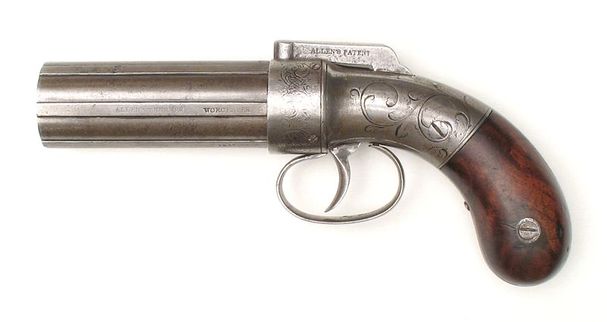Contrary to what I thought, pepper-boxes aren't boxes meant to store pepper. Nop. In this case, a pepperbox or pepperpot is a small revolver, in fact, a multiple-barrel repeating firearm that has three or more barrels grouped around a central axis. It mostly appears in the form of a multi-shot handheld firearm. Pepperboxes exist in all ammunition systems: matchlock, wheellock, flintlock, percussion, pinfire, rimfire and centerfire. And it resembles a pepper grinder, that'd where its name comes from.
The pepperbox, at least the firearm that is mostly associated with this term, was invented in the 1830s and was meant mainly for civilian use. It spread rapidly in the United Kingdom, the USA and some parts of continental Europe. It was similar to the later revolver in that it contained bullets in separate chambers in a rotating cylinder. Unlike the revolver, however, each chamber had its own barrel, making a complex indexing system unnecessary (though pepperboxes with such a system do exist).
This type of firearm was popular in North America from 1830 until the American Civil War, but the concept was introduced much earlier. In the 15th century, several single-shot barrels were attached to a stock, being fired individually by means of a match.
Around 1790, pepperboxes were built on the basis of flintlock systems, notably by Nock in England and "Segallas" in Belgium. These weapons, building on the success of the earlier two-barrel turnover pistols, were fitted with three, four or seven barrels. These early pepperboxes were hand-rotated.
The invention of the percussion cap by Joshua Shaw, building on Alexander Forsyth's innovations, and the industrial revolution allowed pepperbox revolvers to be mass-produced, making them more affordable than the early handmade guns previously only seen in the hands of the rich. Examples of these early weapons are the English Budding (probably the first English percussion pepperbox), the Swedish Engholm and the American threebarrel Manhattan pistol. Most percussion pepperboxes have a circular flange around the rear of the cylinder to prevent the capped nipples being accidentally fired if the gun were to be knocked whilst in a pocket, or dropped.
The pepperbox experienced a kind of "revival" in the late 19th century as a short, easily concealable pocketweapon that used pinfire cartridges. A special variation of this kind of handgun, in which the shortness of the barrel cluster was fully utilized, is the French "Apache revolver." This weapon, allegedly popular among Paris street gangs, was fitted with a folding blade and knuckle-duster. The pepperboxes from this period disappeared with the demise of the pinfire cartridge.
The pepperbox design was also used for a small number of weapon designs in the 20th century, such as the Mossberg produced the Mossberg Brownie (1920), a 4-barrel .22LR pocket-pistol marketed to trappers, and COP 357 Derringer (1970's), produced as a backup weapon for police officers.
The pepperbox, at least the firearm that is mostly associated with this term, was invented in the 1830s and was meant mainly for civilian use. It spread rapidly in the United Kingdom, the USA and some parts of continental Europe. It was similar to the later revolver in that it contained bullets in separate chambers in a rotating cylinder. Unlike the revolver, however, each chamber had its own barrel, making a complex indexing system unnecessary (though pepperboxes with such a system do exist).
This type of firearm was popular in North America from 1830 until the American Civil War, but the concept was introduced much earlier. In the 15th century, several single-shot barrels were attached to a stock, being fired individually by means of a match.
Around 1790, pepperboxes were built on the basis of flintlock systems, notably by Nock in England and "Segallas" in Belgium. These weapons, building on the success of the earlier two-barrel turnover pistols, were fitted with three, four or seven barrels. These early pepperboxes were hand-rotated.
The invention of the percussion cap by Joshua Shaw, building on Alexander Forsyth's innovations, and the industrial revolution allowed pepperbox revolvers to be mass-produced, making them more affordable than the early handmade guns previously only seen in the hands of the rich. Examples of these early weapons are the English Budding (probably the first English percussion pepperbox), the Swedish Engholm and the American threebarrel Manhattan pistol. Most percussion pepperboxes have a circular flange around the rear of the cylinder to prevent the capped nipples being accidentally fired if the gun were to be knocked whilst in a pocket, or dropped.
The pepperbox experienced a kind of "revival" in the late 19th century as a short, easily concealable pocketweapon that used pinfire cartridges. A special variation of this kind of handgun, in which the shortness of the barrel cluster was fully utilized, is the French "Apache revolver." This weapon, allegedly popular among Paris street gangs, was fitted with a folding blade and knuckle-duster. The pepperboxes from this period disappeared with the demise of the pinfire cartridge.
The pepperbox design was also used for a small number of weapon designs in the 20th century, such as the Mossberg produced the Mossberg Brownie (1920), a 4-barrel .22LR pocket-pistol marketed to trappers, and COP 357 Derringer (1970's), produced as a backup weapon for police officers.
~Ally

 RSS Feed
RSS Feed